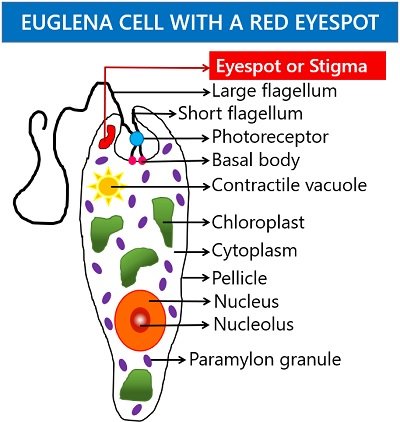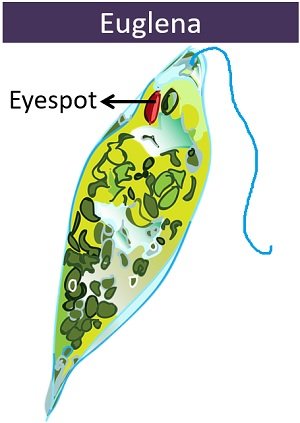Euglena eyespot is also called stigma or eyespot apparatus. It generally has a bright red colour appearance. Euglena is a unicellular photosynthetic organism having an eyespot apparatus as a light-receptive organelle. The red colour of the eyespot in Euglena is due to the presence of carotenoid pigment granules.
In addition, it contains photoreceptors, structural, metabolic and signalling proteins. Carotenoid rich granules aggregate around a reservoir and photoreceptor crystal. Photoreceptor proteins generally exist in the plasma membrane overlying the pigmented bodies.
Euglena has a tiny dark eyespot at its front or anterior end. This post mainly describes the definition, location, function of the eyespot apparatus within the euglena cell. You will also get to know the mechanism of eyespot mediated light perception.
Content: Euglena Eyespot
Definition of Eyespot
Eyespot refers to the heavily pigmented region, prevalently seen in the motile green algae and some unicellular photosynthetic organisms. It functions as a photoreceptive organelle that detects light. The eyespot apparatus is a combination of photoreceptor proteins and carotenoid screening pigments. This combination helps in detecting light directionality.

The eyespot in Euglena is present towards the anterior portion or close to the paraflagellar body. It facilitates signalling between the photoreceptors and effector organelles like flagella. Eyespots are light-sensitive structures classified mainly into five types (Type-A, B, C, D and E). Flavoproteins and Retinylidene are the two major eyespot proteins. Euglena has a type-D eyespot and it contains flavoproteins. After staining an eyespot or stigma with osmium tetraoxide, a black precipitate forms.
Location of Eyespot Apparatus in Euglena
The group of Euglenophyta are phytoflagellates having eyespot at the anterior end or near the reservoir. The eyespot of Euglenophyta appears as a distinct dark spot within the cell. It is localized near the paraflagellar body (PFB) and towards the base of the large flagellum.
The eyespot apparatus contains the paraflagellar body that adjoins the eyespot with the flagellum. The paraflagellar body contains light-sensitive photoreceptor proteins that assist in phototaxis. Conversely, the large flagellum provides motility to the members of Euglenophyta.

Eyespot Apparatus Functions
- It plays a significant role in photoreception. The eyespot contains carotenoid‐rich globules that serve as the screening pigment or reflector device.
- In addition, photoreceptor proteins of Euglena generally include flavoproteins that possess photo behavioural functions.
- It is usually considered as a pigmented apparatus with a stacked membrane. The eyespot within the cell of Euglena helps in light guided behaviour and facilitates signalling between the sensor (photoreceptors) and effector organelles (flagella). Therefore, Euglena shows phototaxis in response to the light stimulus.
- Euglena senses the light stimulus via pigmented stigma and can find areas with optimal light conditions to utilize sunlight for efficient photosynthesis.
- Nevertheless, the eyespot apparatus influences flagellar movement in Euglena.
Mechanism of Eyespot-Mediated Light Perception
- Activation of photosensory pigments: Blue light stimulates the activity of photosensitive adenylate cyclase within the Euglena.
- Conversion of light signal into a chemical signal: Adenylate cyclase excites the receptor proteins to produce cyclic adenosine monophosphate (cAMP). Here, cAMP serves as a second messenger.
- Transfer of information to the flagella: The cAMP production triggers chemical transduction that ultimately alters the flagellar beat patterns and results in a cell movement or phototaxis.
Euglena shows phototaxis or phototactic movement in response to the light stimulus. Phototaxis is a directional locomotory movement seen in unicellular and multicellular phototactic organisms, which can be positive or negative.
Positive phototaxis is a directional movement of cells towards the increasing light intensity, whereas negative phototaxis is a directional movement away from the increasing light intensity. Euglenophyceae are phytoflagellates that exhibit positive phototaxis.
Euglena uses its large flagellum to show phototactic steering. They couple their locomotion strategy with a light-sensitive “Eyespot apparatus” or “Stigma”. Eyespot in Euglena contains several hundreds of lipid globules rich in carotenoid pigments.
Photoreceptors of Euglena contain flavin molecules as chromophores. Photoreceptors and pigmented shading device or eyespot control the phototaxis movement. Orientation and subsequent directed movement are the two stages involved in phototaxis.
Euglena rotates about its long axis. The flagellum moves around its base or an anterior portion, thereby pushing Euglena backwards. When the light falls on one side of the photoreceptor, the eyespot apparatus in Euglena periodically shades the photoreceptors to initiate phototaxis.
This screening function of the eyespot causes a succession of phobic responses that allows movement of the Euglena towards the increasing light source. After an organism’s orientation, a continuous shading of the photoreceptor results and no further phobic response occurs.
Conclusion
Therefore, we can conclude that a pigmented shading device or eyespot appears as a red eyespot within the Euglena that helps in light perception and direction of movement. It is close to the reservoir and sensitive to the light stimulus.